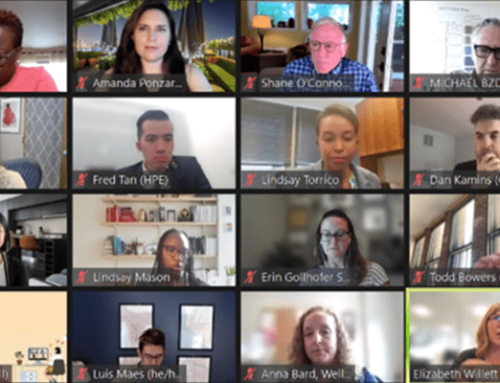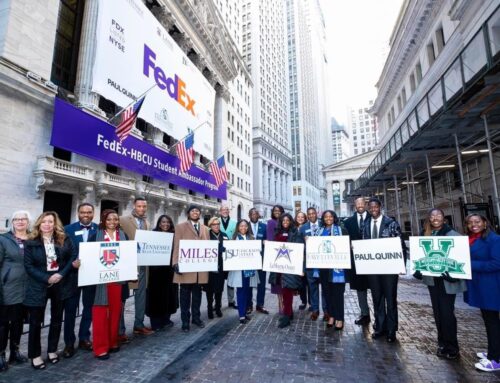By: Jerome Tennille, MSL, CVA, Manager of Volunteerism for Marriott International;
Corporate Volunteerism: Thinking “Strategic” Isn’t Enough My Friends
– In what’s becoming a series of posts by Meridian Swift (a renowned leader in the field of volunteer engagement) it’s suggested non-profit volunteer engagement professionals create more strategy to better engage companies in what’s coined “corporate volunteerism”. She’s correct. Corporate volunteerism is often mismanaged, undervalued and should be thought of as more than a one-and-done. Philosophically we can debate whether calling it corporate volunteerism is correct. We’re not doing that today. Rather, we’ll get to the crux of much deeper issues and accompanying pitfalls that can stall your progress.
In the post titled “Removing the Headache from Corporate Volunteerism,” Swift urges non-profit volunteer engagement professionals to more strategically build a plan that includes volunteers from corporations. While Swift is correct in the action that must be taken by managers of volunteers, I believe that’s only addressing symptoms of a larger problem.
Let me first validate a few things; yes, the pain you’ve felt is due in part by non-profit leadership largely undervaluing volunteers (and the profession). Yes, this has implications on volunteerism being understood as a strategic asset. Yes, this also undermines the legitimacy of corporate volunteerism because of how non-profit volunteer engagement professionals are forced to react to it. All of that is true. But the bigger issue is the divide between non-profits and corporations. They’re the two main ingredients in this recipe. Both are coming together with a different language and ideology. Non-profits and for-profits are designed for two very different things. Albeit that’s changing as companies becoming more purposeful. But it’s not happening at breakneck speed. None of that changes the fact that there’s a noticeable divide. Nor does it change the stress that’s felt (on both sides) when engaging in corporate volunteerism. Let me reiterate though, that stress is just the symptom of a disconnect.
To overcome such a divide, we must seek alignment on more than just projected outcomes of programming. We need to get on the same page linguistically and ideologically. You see, this isn’t just a non-profit problem, nor is it a corporate problem. Sure, we can backbite about how leaders at non-profits don’t value or fully integrate volunteerism into the organization strategically or holistically. We can also complain about how ill-informed corporate social responsibility (CSR) practitioners (and the employees they send to volunteer) seek engagement. But one party being better equipped or informed doesn’t do any good. That’s like having a car without gas, or a canister of gas without a car. One without the other leaves you in a bind. You need both.
Let me address a few things before we get to what I know to be the solution to this madness.
Corporate volunteerism is more than a “thing”:
If there’s any way to understand corporate volunteerism it’s by first not referring to it as becoming a thing. Let’s be clear, it was becoming a thing twenty years ago. Today it’s a monster, and it’s eating your lunch if you work for a non-profit. Now, I’ll say that I believe Swift was referring to corporate volunteerism as becoming a thing in the sense that it’s front and center in conversation. However, I believe that the overall sentiment is still very flippant in how corporate volunteerism is valued and understood in the non-profit sector at large. For example, people debate whether you should consider employee volunteers that receive Paid Volunteer Time Off (PVTO) as volunteering because the company is paying them during their volunteer activity. It’s lunacy we’re even having that debate. You wouldn’t debate calling your time off through the summer a vacation when you take Paid Time Off (PTO) to spend time with family. That’s just one example.
Even though Swift uses playful language in her post, I’d say that most non-profit volunteer engagement professionals still see it as a thing in the pejorative sense. But it’s more than that, here’s why.
Everything from what folks are calling the “Starbucks initiative” (which is a brilliant idea by the way) to younger generations seeking employment with socially responsible companies is what I would call the greater evolution of this thing that’s existed for over two decades. Swift writes “we are seeing an increase in participation by employee groups” I’d push back and say we’re seeing the consistent evolution that many have missed. There’s been an undercurrent of activity and it largely went unnoticed. Not because people weren’t looking, but because they were (and still are) looking in the wrong places and having the wrong conversations. I tend to believe this is due in part by non-profits largely being behind the curve on CSR trends. This is a part of that divide I mention. Non-profit professionals having little dialogue with CSR practitioners about the same thing, the topic of volunteerism. Name a global, national or local forum where the primary intention is to advance the culture of volunteerism with both non-profit and CSR volunteer engagement professionals in the same room. You probably can’t. The only newly formed organization that’s seeking to do that (as its primary goal) is The National Alliance.
Corporate volunteerism, then and now:
When I was at last year’s 3BL Forum’s Brands Taking Stands conference I had the opportunity to watch Chris Coulter, CEO of Globe Scan give a presentation on the evolution of business. One of many topics he covered was what he called the era of business leadership, where companies were functioning beyond their profit to some degree. The three eras included the following;
- Harm Reduction Era (1997 – 2005)
- Strategic Integration Era (2006 – 2015)
- Purpose Driven Era (2016 – Ongoing)
In each era corporate volunteerism existed. The execution (and expectation from society) was just different. Whether or not you knew this, corporate volunteerism has existed at many legacy companies since the nineties. For some companies even before that. Today companies are getting more sophisticated, doing it better. It’s becoming more a part of what’s being considered a part of business. Companies that don’t do it will cease to exist. I tend to believe that you just see more companies doing it with greater focus.
I would also say that we’re in a space where business is becoming so purposeful that they (in some cases) don’t need non-profit organizations to volunteer in the community. They can just do it. For non-profits that can’t adjust, they’ll become less relevant. I’d actually point you to a podcast that featured Ben Bisbee, where he talks about this to a great degree. If you work at a non-profit as a volunteer engagement professional, I urge you to get in front of this. Do so by staying on top of corporate social responsibility trends. There’s an entire field of professionals like myself who are your counterparts at for-profit companies. Connect with us, better understand what we do, what we see on the horizons for the companies we work for and bridge that divide. Break out of your silos and expand your understanding of volunteer engagement.
More than a one-and-done:
Regarding non-profit leadership, Swift writes “They don’t think about the potential partnership with a corporation that follows a volunteer activity. They don’t consider the donations that might pour in when a corporate group sees firsthand the good work being done. Nope, it’s ‘just’ a one and done volunteer afternoon. Move along, nothing to see here.” I would agree with this only partly. While many corporations are still seeking that one-and-done “employee engagement” opportunity, it’s been my experience that non-profit staff often see the one-off volunteer engagement as the door to potential monetary funding (even if it’ll never exist).
There are a few things to address here. One being that corporations are still seeking one-off volunteer activities for that check-in-the-block focused on employee engagement. But, secondly, it’s how both groups define “partnership”. The way partnerships are understood from the perspective of the for-profit company is often different. I find that non-profit professionals are looser with what a partnership entails compared to CSR professionals. This is where both groups differ in language, and it matters. There are many organizations that companies volunteer at where the company doesn’t acknowledge that engagement as a partnership. So, just be careful in how this is understood. Seek clarification on how your for-profit counterparts define that.
Separately, it’s also my experience that through the eyes of many non-profit leaders, volunteer engagement is seen as a gateway. It’s seen as a means to an end. That end being long-term funding. As a result, the volunteer engagement professional’s expertise and voice is undermined and viewed merely as a cog in the wheel.
Let me let you all in on a little lesser-known piece of information. If you’re really seeking more than a one-and-done, you need to connect with that company’s CSR team. If it’s a small or medium sized company, they might not have a dedicated CSR team or person. In that instance you’ll need to sluice out who that person is. Here’s why. As Swift writes in “Creating Partnerships from Corporate Volunteering”, creating partnerships with a company boils down to doing it “in the same way we do with individual volunteers. We look for motivations and the opportunity to build a sustainable relationship.” But there’s a catch, employees you engage from a company aren’t always apprised of their company’s strategy, the reasons why, etc. Nor are they usually the one making the decisions on whether that company engage in something long-term.
Let’s take a look at some of the statistics outlined in the article by The Republic (referenced in Swift’s post). Most notably are those cited by the Society for Human Resource Management (SHRM) indicating 24% (nearly 1 in every 4) companies providing time off to volunteer for their employees. That coupled with the growing desire of employees to give their time and money to who they choose (and not that of their employer) you get an ability to connect with employees on a more individualistic level. But, the result of that is you partly lose the connection to the company itself. Additionally, while more voice and choiceis being afforded to employees, companies are increasingly building more strategy behind the how of doing that. So, ask yourself this, who creates that strategy? Those are the folks you truly need to connect to. It’s not enough to connect with the employees from that company, they often don’t drive the strategy or tug the purse strings financially from where corporate contributions and large grants come from.
Just one small lasting thought on that. First, do your research, understand what a company is seeking. CSR practitioners don’t enjoy the many ill-informed solicitations they receive daily. Secondly, be incredibly sensitive and careful on how you seek what you define as a partnership. Neither one of these thoughts however will fix the larger issue. So, you may wonder what I have in mind. Here’s what I’ll share about fixing this mess.
To “fix” corporate volunteerism you must switch sides:
I’m playing chess, not checkers.
Nothing described above can be fixed by simply “being more strategic”. It requires a rethink of how non-profit leadership and for-profit companies operate. I’m going to triple-down on a position that I’ve been advocating for, and it’s counter-intuitive, so be sure you’re sitting down before reading further.
To change what you perceive to be wrong or broken about corporate volunteerism, you need to leave the profession of non-profit volunteer engagement. You need to seek avenues that elevate you to a position that has long-term positive change for volunteer engagement as a profession. In a 2017 post by Elisa Kosarin (another respected leader of volunteers) I suggest non-profit volunteer engagement professionals seek positions as Executive Directors, CEO’s and even CSR practitioners.
In a more senior position you have more influence in how volunteers engage throughout the organization. Separately, as a CSR practitioner you can better position companies to engage in volunteerism more smartly. I took the route of CSR practitioner. In my role I have the privilege and opportunity to design employee and corporate volunteerism programs.
Different than many in my field, I do so with my perspective and experience from the non-profit sector. I believe it equips me to do my job better for the communities we serve and the non-profit organizations we’re volunteering with. Matter of fact, I spoke on a panel at the 18th Annual Charities@Work Employee Engagement Summit my non-profit experience giving me an edge in the work I do. I and the other panelists suggested to a room with over one-hundred other CSR practitioners that they should hire those with a non-profit background. I speak the same language as my non-profit counterparts, I can better help them navigate engagement with the company I work for, I can share my non-profit insight with my colleagues and do so while educating others and challenging the status quo.
Sometimes you must seek the opportunity to be the change you wish to see. We’re all seeking the same result (engaging in corporate volunteerism more expertly). I believe to do that more effectively we must seek greater understanding and diversity of thought. Remember, this is about addressing deeper rooted issues, not placing Band-Aids on scratches. Some of this starts with dialogue, so whether you agree or disagree, let me know your thoughts. I look forward to hearing from you.
Note: The thoughts and views expressed in this post reflect my personal views alone and are not those of Marriott International or any of its brands.

Jerome Tennille, Manager of Volunteerism for Marriott International
Jerome Tennille is the Manager of Volunteerism for Marriott International, where he leads the company’s traditional and skills-based volunteer programs, ensuring they reflect the latest innovations, technologies, and best practices. This includes Marriott’s global week and month of community service, providing the framework, resources, and support needed for volunteerism efforts to be executed both globally and locally.







